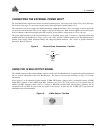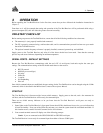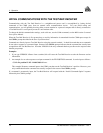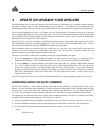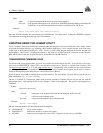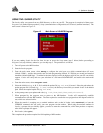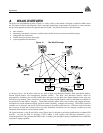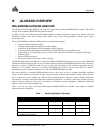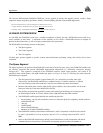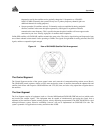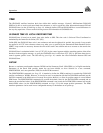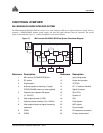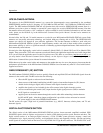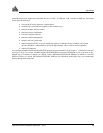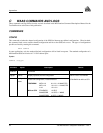
Appendices
Test Bed Receiver Subsystem Addendum – Rev 1 23
B GLONASS OVERVIEW
MILLENNIUM-GLONASS GPSCARD
The MiLLennium-GLONASS GPSCard can receive L1 signals from combined GPS/GLONASS satellites. This hybrid
receiver offers combined GPS/GLONASS position solutions.
An RTK version of the MiLLennium-GLONASS GPSCard performs significantly better when tracking GPS and
GLONASS satellites, than when tracking GPS satellites only. Faster floating-ambiguity solutions mean shorter
observations times.
The use of GLONASS in addition to GPS provides very significant advantages:
increased satellite signal observations
markedly increased spatial distribution of visible satellites
reduction in the Horizontal and Vertical Dilution of Precision factor
no special precision degrading mode in GLONASS (unlike GPS Selective Availability mode)
single frequency (L1) positioning accuracy is about 4 times better for GLONASS as compared to GPS single
frequency signals
improved RTK performance
decreased occupation times result in faster surveying
The MiLLennium-GLONASS GPSCard is capable of combined GPS/GLONASS operation. In order to track GLONASS
satellites the MiLLennium must track at least one GPS satellite to determine the GPS/GLONASS time offset. In order to
determine a position in GPS-Only mode the receiver must track a minimum of four satellites, representing the four
unknowns of 3-D position and time. In combined GPS/GLONASS mode the receiver must track five satellites,
representing the same four previous unknowns as well as the GPS/GLONASS time offset.
With the availability of combined GPS/GLONASS receivers, users have access to a potential 48-satellite combined
system. With 48 satellites, performance in urban canyons and other locations with restricted visibility, such as forested
areas, is improved, as more satellites are visible in the non-blocked portions of the sky. A larger satellite constellation
also improves real-time carrier-phase differential positioning performance. In addition, stand-alone position accuracies
improve with the combined system, and in the absence of deliberate accuracy degradation, differential GLONASS
requires a much lower correction update rate.
Table 1 lists the two types of NovAtel MiLLennium-GLONASS GPSCards available, each capable of multiple
positioning modes of operation:
Table 1 Positioning Modes of Operation
Positioning Modes of Operation MiLLennium-GLONASS GPSCard
MiLLen-G MiLLen-G-RT10 TESTBEDGLO
Single Point
√ √ √
Waypoint Navigation
√ √ √
Pseudorange differential corrections (TX & RX)
√ √ √
RTK pseudorange & carrier-phase double differencing:
< 10 cm RMS accuracies (floating)
X
√
X



